Criteria
Beighton 9-point scoring system for joint hypermobility[16]
Based on ability to perform a series of manoeuvres:
Dorsiflex the 5th metacarpophalangeal joint to 90° or greater (1 point for each side) [Figure caption and citation for the preceding image starts]: Joint hypermobility demonstrated by hyperextension of the fifth metacarpophalangeal jointFrom the collection of Dr Rodney Grahame; used with permission [Citation ends].
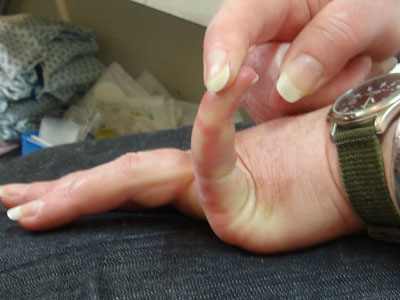
Oppose the thumb to the volar aspect of the ipsilateral forearm (1 point for each side) [Figure caption and citation for the preceding image starts]: Joint hypermobility demonstrated by opposition of thumb to volar aspect of forearmFrom the collection of Dr Rodney Grahame; used with permission [Citation ends].
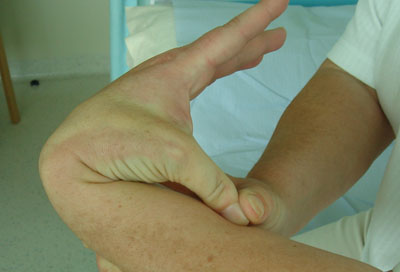
Hyperextend the elbow to 10° or greater (1 point for each side) [Figure caption and citation for the preceding image starts]: Joint hypermobility demonstrated by hyperextension of the elbow to >90°From the collection of Dr Rodney Grahame; used with permission [Citation ends].
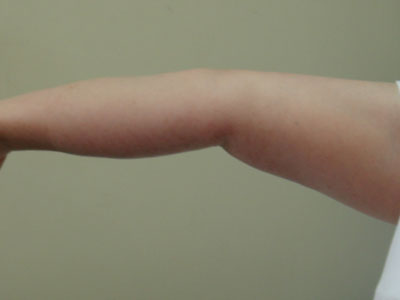
Hyperextend the knee to 10° or greater (1 point for each side) [Figure caption and citation for the preceding image starts]: Joint hypermobility demonstrated by hyperextension of the kneeFrom the collection of Dr Rodney Grahame; used with permission [Citation ends].
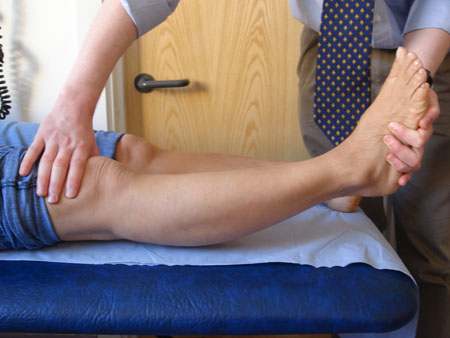
Place the hands flat on the floor with the knees fully extended (1 point). [Figure caption and citation for the preceding image starts]: Joint hypermobility demonstrated by placing hands flat on floor with knees fully extendedFrom the collection of Dr Rodney Grahame; used with permission [Citation ends].
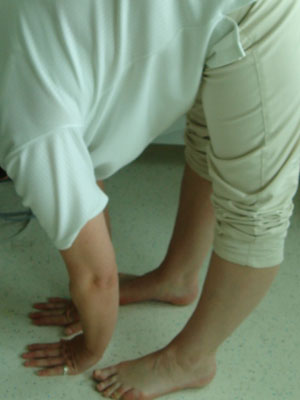
A score of 5/9 or higher is usually taken to indicate generalised hypermobility.
A video demonstration of Beighton score in a hypermobile Ehlers-Danlos syndrome patient.
2017 international EDS criteria[5]
Categorises EDS into 13 subtypes.
Includes major and minor diagnostic criteria by which a clinical diagnosis of a particular subtype can be made. Genetic testing is required for the definitive diagnosis of all subtypes except for hypermobile EDS (hEDS) which is clinical diagnosis only, and therefore the revised criteria are important to help distinguish it from other joint hypermobility disorders.
Diagnosis of hypermobile EDS (hEDS)
For the clinical diagnosis of hEDS, the following three criteria must be satisfied:
Criterion 1
Beighton score
Pre-pubertal children and adolescents: ≥6
Men and women, post-puberty up to age 50 years: ≥5
Men and women older than 50 years: ≥4
If Beighton score is 1 point below the cutoff, and 5 Point Questionnaire is 'positive' (at least 2 items), a diagnosis of generalised joint hypermobility (GJH) may be made.
5 Point Questionnaire (5PQ)
Can you now (or could you ever) place your hands flat on the floor without bending your knees?
Can you now (or could you ever) bend your thumb to touch your forearm?
As a child, did you amuse your friends by controlling your body into strange shapes, or could you do the splits?
As a child or teenager did your shoulder or kneecap dislocate on more than one occasion?
Do you consider yourself double jointed?
Criterion 2
2 or more of the following features must be met (A and B, A and C, B and C, or A and B and C):
Systemic manifestations of a more generalised connective tissue disorder (at least 5 of the following must be present):
Unusually soft or velvety skin
Mild skin hyperextensibility
Unexplained striae without a history of significant weight change
Bilateral piezogenic papules of the heel
Recurrent or multiple abdominal hernia(s) (e.g., umbilical, inguinal, crural)
Atrophic scarring involving at least 2 sites and without the formation of truly papyraceous and/or hemosideric scars as seen in classical EDS
Pelvic floor, rectal, and/or uterine prolapse in children, men, or nulliparous women without a history of Class III obesity (body mass index 40 kg/m² or above) or other known predisposing medical condition
Dental crowding and high or narrow palate
Arachnodactyly, as defined in one or more of following: 1) positive wrist sign (Steinberg sign) on both sides; 2) positive thumb sign (Walker sign) on both sides
Arm span-to-height ratio ≥1.05
Mitral valve prolapse (MVP) mild or greater based on strict echocardiographic criteria
Aortic root dilation with Z-score >+2
Positive family history
One or more first-degree relatives independently meeting the diagnostic EDS criteria
Musculoskeletal complications (one of the following must be present):
Musculoskeletal pain in 2 or more limbs, recurring daily for at least 3 months
Chronic, widespread pain for 3 or more months
Recurrent joint dislocations or frank joint instability, in the absence of trauma
3 or more atraumatic dislocations in the same joint or 2 or more atraumatic dislocations in 2 different joints occurring at different times
Medical confirmation of joint instability at 2 or more sites, unrelated to trauma.
Criterion 3
All prerequisites required:
Absence of unusual skin fragility, which should prompt consideration of other subtypes of EDS
Exclusion of other heritable and acquired connective tissue disorders, including autoimmune rheumatological conditions
In patients with an acquired/autoimmune connective tissue disorder, additional diagnosis of hypermobile EDS (hEDS) requires meeting both features A and B of criterion 2. Feature C of criterion 2 (chronic pain and/or instability) cannot be counted towards a diagnosis of EDS
Exclusion of alternative diagnoses that may also include joint hypermobility by means of hypotonia and/or connective tissue laxity.
A framework for the classification of joint hypermobility and related conditions in adults and skeletally mature adolescents[4]
Hypermobility spectrum disorder (HSD) is used as a diagnosis for patients with symptomatic joint hypermobility who do not have any of the rare subtypes of EDS and do not meet the criteria for hEDS.
Four different HSDs are recognised:
Generalised (joint)
Peripheral (joint)
Localised (joint)
Historical (joint)
Individuals who previously met the Beighton criteria for hEDS but do not meet the 2017 criteria for hEDS can be diagnosed as having HSD.
The Paediatric Working Group of the International Consortium on EDS and HSD diagnostic framework for joint hypermobility in children[35]
This diagnostic framework for children has four components:
Generalised joint hypermobility (Beighton score of ≥6)
Skin and tissue abnormalities (soft skin, stretchy skin, atrophic scars, stretch marks, piezogenic papules, and recurrent hernias)
Musculoskeletal complications (episodic activity related pain, joint dislocations/subluxations, soft tissue injuries)
Core/systemic comorbidities (chronic pain, chronic fatigue, functional gastrointestinal or bladder disorder, primary dysautonomia, anxiety).
By combining the different components, eight sub-groups are generated: four paediatric generalised joint hypermobility, and four paediatric generalised hypermobility spectrum disorders. Only biologically mature adolescents who meet the 2017 criteria should be diagnosed with hEDS. The 2017 criteria also cover diagnosis of rarer subtypes of EDS at any age.
Use of this content is subject to our disclaimer
